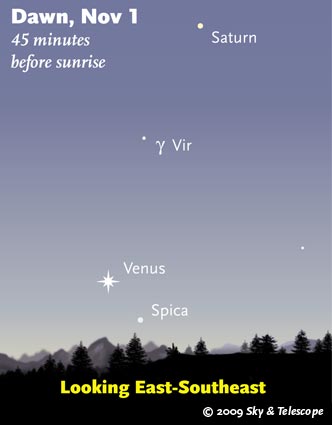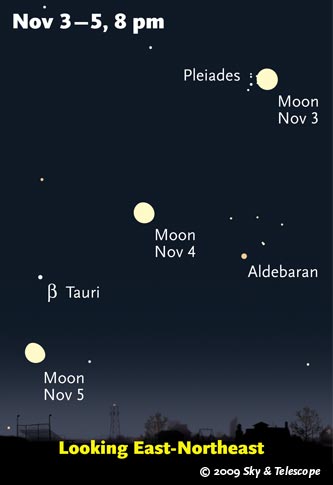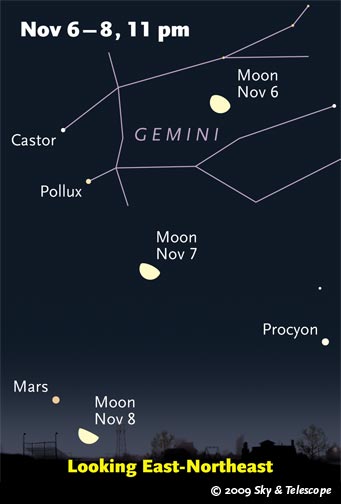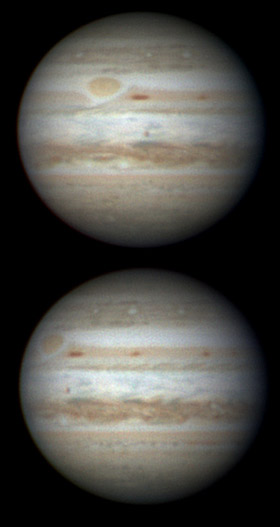Some daily events in the changing sky for October 30 – November 7

Two planets accompany stars of Virgo in the east-southeast at dawn. This is their configuration on the morning after Halloween night. The visibility of faint objects in bright twilight is exaggerated here; you may need binoculars for all but Venus.
Sky & Telescope diagram
Friday, October 30
Saturday, October 31
Sunday, November 1
Monday, November 2

The Moon skims the Pleiades Tuesday night as seen from North America. These scenes are always plotted exactly for a viewer near the center of North America (at latitude 40° north, longitude 90° west). For clarity, the Moon is always drawn three times its actual apparent size.
Sky & Telescope diagram
Tuesday, November 3
Wednesday, November 4
Thursday, November 5

As the Moon wanes further, it rises later. By Saturday November 8th it's down next to Mars.
Sky & Telescope diagram
Friday, November 6
Saturday, November 7
Want to become a better amateur astronomer? Learn your way around the constellations. They're the key to locating everything fainter and deeper to hunt with binoculars or a telescope. For an easy-to-use constellation guide covering the whole evening sky, use the big monthly map in the center of each issue of Sky & Telescope, the essential magazine of astronomy. Or download our free Getting Started in Astronomy booklet (which only has bimonthly maps).

The Pocket Sky Atlas plots 30,796 stars to magnitude 7.6 — which may sound like a lot, but that's less than one star in an entire telescopic field of view, on average. By comparison, Sky Atlas 2000.0 plots 81,312 stars to magnitude 8.5, typically one or two stars per telescopic field. Both atlases include many hundreds of deep-sky targets — galaxies, star clusters, and nebulae — to hunt among the stars.
Sky & Telescope
Once you get a telescope, to put it to good use you'll need a detailed, large-scale sky atlas (set of charts; the standards are Sky Atlas 2000.0 or the smaller Pocket Sky Atlas) and good deep-sky guidebooks (such as Sky Atlas 2000.0 Companion by Strong and Sinnott, the more detailed and descriptive Night Sky Observer's Guide by Kepple and Sanner, or the classic Burnham's Celestial Handbook). Read how to use them effectively.
Can a computerized telescope take their place? I don't think so — not for beginners, anyway (and especially not on mounts that are less than top-quality mechanically). As Terence Dickinson and Alan Dyer say in their Backyard Astronomer's Guide, "A full appreciation of the universe cannot come without developing the skills to find things in the sky and understanding how the sky works. This knowledge comes only by spending time under the stars with star maps in hand and a curious mind." Without these, "the sky never becomes a friendly place."
More beginners' tips: "How to Start Right in Astronomy".
This Week's Planet Roundup

Jupiter's Great Red Spot remains clearly separated from the South Equatorial Belt (SEB) by a wide, white Red Spot Hollow. Note the small, very dark red barges following behind. The SEB seems to be calming and fading; the NEB is darker and much busier. South is up.
Christopher Go took these images on October 26th at 11:12 and 12:07 UT. Stacked-video images like these show much more detail than you're ever likely to see visually on Jupiter.
Christopher Go
Mercury is in superior conjunction, behind the glare of the Sun.
Venus (magnitude –3.9) is sinking lower in the dawn every week. Look for it low in the east 60 to 30 minutes before your local sunrise time. Use binoculars to look for twinkly little Spica to Venus's lower right early in the week, directly right of Venus around November 4th (by 4°), and to Venus's upper right thereafter. Look too for Saturn much higher to their upper right.
Mars (magnitude +0.4, in central Cancer) rises around 11 p.m. standard time below Castor and Pollux in the east. It's very high in the southeast before dawn. Use binoculars to watch Mars crossing the Beehive star cluster from the mornings of October 31st to November 2nd.
In a telescope Mars is only about 8 arcseconds wide: a tiny, fuzzy gibbous blob. Mars is on its way to an unremarkable opposition late next January, when it will be 14.1 arcseconds wide.
Jupiter (magnitude –2.4, in Capricornus) shines brightly in the south at dusk and lower in the southwest later in the evening. It sets around midnight.
Saturn (magnitude +1.1, in the head of Virgo) is getting higher the east-southeast before and during dawn. More than 20° to its lower left is bright Venus.
Uranus (magnitude 5.8, below the Circlet of Pisces) is well up in the south during evening.
Neptune (magnitude 7.9, in Capricornus) is 6° east of Jupiter.
See our finder charts for Uranus and Neptune. For a guide to spotting the challenging satellites of Uranus and Neptune at any date and time (you'll need a big scope), see the October Sky & Telescope, page 59.
Pluto (14th magnitude, in Sagittarius) is disappearing into the sunset.
All descriptions that relate to your horizon or zenith — including the words up, down, right, and left — are written for the world's mid-northern latitudes. Descriptions that also depend on longitude (mainly Moon positions) are for North America. Eastern Daylight Time (EDT) equals Universal Time (also known as UT, UTC, or GMT) minus 4 hours. Eastern Standard Time (EST) is UT minus 5 hours.
To be sure to get the current Sky at a Glance, bookmark this URL:
http://SkyandTelescope.com/observing/ataglance?1=1
If pictures fail to load, refresh the page. If they still fail to load, change the 1 at the end of the URL to any other character and try again.
 0
0
Comments
You must be logged in to post a comment.